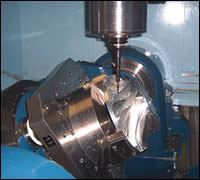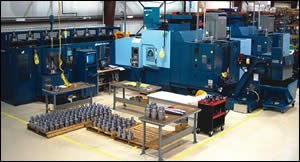Minimizing Part Setup With Five-Axis Technology
More unattended machining was one of the benefits of this shop's move from four-axis to five-axis machines.
BHI Corporation recently faced a decision regarding expansion. The obvious answer would have been to continue to produce, using its existing processes of multiple four-axis machining centers with two-axis turning centers (which would necessitate adding personnel), or else find a more efficient solution. The company sought and found a “Performance Partnership” with Koch Machine Tool, (Houston, Texas) and Sudbury, Massachusetts-based Methods Machine Tools.
Luke Brader founded BHI in 1971. When approached to open facilities overseas, Mr. Brader chose instead to invest in the United States. The company says it soon fell into the trap that so many job shops are familiar with when it comes to growth—if it works, then copy it. The underlying problem is that when a company acquires new equipment to run the same old jobs, it tends to go about production as it would have 30 years ago. Mr. Brader instinctively realized that a better approach was out there. Alert to the recent advances in foreign competition, he sought to distinguish the company as a predominate player in the oil field market.
The ISO 9000 compliant company offers engineering, turning, milling and assembly in Inconel 718, 304 stainless, K Monel and other difficult-to-machine materials. Originally built as an oil field job shop, the company began with two employees in a rented boat shed. It has now diversified its clientele to include businesses in the defense, aerospace and power generation industries. This strategy has worked for BHI, which has grown into a 52,000-square-foot facility with 48 employees.
Early in the thought process, Mr. Brader understood that a five-axis machine would enable him to minimize part setups. He also understood that an automatic pallet shuttle would maximize the spindle’s in the cut time. After researching many options, Mr. Brader met with Tim Koch of Koch Machine Tool, who presented the Matsuura MAM72-63V as a possible solution. With its built-in trunnion system and an automatic pallet system that allows for traditional four-axis work, this machining center addressed the company’s need for five-axis machining.
BHI subsequently formed the Performance Partnership with Koch Machine Tool and Methods Machine Tools in which BHI brought the challenge of viability in the global context to the table, and that Koch and Methods provided the means for the company to actualize that vision.
The solution grew from a two-pallet system to a 17-pallet system capable of running through the weekend. The tool changer accommodates as many as 240 tools, and it eliminates setup of tools on new jobs. It is also capable of holding “sister” tools. Both probes and tool detection were added to achieve the required unattended machining.
After the first machine was installed, unattended, “lights out” machining was accomplished. Shortly after that, a second machine was ordered.
“Our new goal is to have one machinist oversee multiple machines that are operating 24/7,” Mr. Brader concludes.
Related Content
Will the “Great Resignation” Become an Opportunity for Manufacturers? Get Ready for the Returning 3 Million
The Great Resignation will become a Great Reapplication when employees currently able to stay out of the workforce return to it looking for something better. Machining employers that are already evaluating candidates for fit, without demanding specific skills coming in, might be positioned well to draw upon this wave.
Read MoreCan Connecting ERP to Machine Tool Monitoring Address the Workforce Challenge?
It can if RFID tags are added. Here is how this startup sees a local Internet of Things aiding CNC machine shops.
Read More8 Ways to Increase Productivity on the Manufacturing Floor
When it comes to machine shop productivity, continuous improvement depends on efficient employees, equipment and processes.
Read MoreSolve Worker Shortages With ACE Workforce Development
The America’s Cutting Edge (ACE) program is addressing the current shortage in trained and available workers by offering no-cost online and in-person training opportunities in CNC machining and metrology.
Read MoreRead Next
3 Mistakes That Cause CNC Programs to Fail
Despite enhancements to manufacturing technology, there are still issues today that can cause programs to fail. These failures can cause lost time, scrapped parts, damaged machines and even injured operators.
Read MoreThe Cut Scene: The Finer Details of Large-Format Machining
Small details and features can have an outsized impact on large parts, such as Barbco’s collapsible utility drill head.
Read MoreObscure CNC Features That Can Help (or Hurt) You
You cannot begin to take advantage of an available feature if you do not know it exists. Conversely, you will not know how to avoid CNC features that may be detrimental to your process.
Read More



























